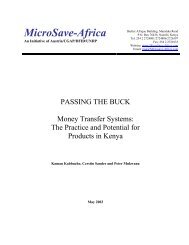Create successful ePaper yourself
Turn your PDF publications into a flip-book with our unique Google optimized e-Paper software.
Photo by Bernard Pierre Wolff/UNDP<br />
Women in Development<br />
In 1996, USAID announced its “Gender Plan <strong>of</strong> Action,” the<br />
central component in the Women in Development Technical<br />
Assistance (WIDTECH) Project. Over the next four <strong>years</strong>, <strong>DAI</strong><br />
handled many task orders under the WIDTECH umbrella. The<br />
GenderReach project, for example, supported communications<br />
and workshops to provide development assistance to<br />
women.<br />
Under an initiative called GenderCounts, <strong>DAI</strong> provided<br />
gender and human capacity advisors to strengthen efforts<br />
at USAID missions. At the same time, the Strategies for<br />
Advancing Girls’ Education task order financed workshops<br />
aimed at promoting girls’ education in Asia and the Near<br />
East. The project was capped by the unveiling <strong>of</strong> a website<br />
that provided detailed information and support for women in<br />
developing countries.<br />
Weeding and preparing a cornfield in Ecuador.<br />
56<br />
managing director. Saffer, who had run the successor project<br />
to GEMINI’s Poland buy-in, brought a strong entrepreneurial<br />
drive and immediately saw growth possibilities. First renamed<br />
Ebony Consulting International and subsequently ECIAfrica,<br />
the firm turned the corner by winning a key implementing role<br />
in USAID’s South Africa International Business Linkages<br />
(SAIBL) Project. <strong>DAI</strong> seconded Bill Grant, a 10-year veteran<br />
<strong>of</strong> the firm with agribusiness and microenterprise expertise,<br />
to join Saffer in 1999, and he remained at ECIAfrica for<br />
more than six <strong>years</strong>. Aside from SAIBL, most <strong>of</strong> ECIAfrica’s<br />
business came from projects beyond <strong>DAI</strong>’s typical client<br />
base, and it enjoyed considerable autonomy for as long as it<br />
remained pr<strong>of</strong>itable. As in London, however, the downside <strong>of</strong><br />
autonomy was a failure to leverage <strong>DAI</strong>’s assets or achieve a<br />
good strategic fit with the parent company.<br />
A New Look on Old Tasks<br />
As <strong>DAI</strong> pushed out in different directions, it also put a new<br />
look on more established lines <strong>of</strong> business. Mickelwait<br />
believed that commercial agriculture would be a critical<br />
component <strong>of</strong> <strong>DAI</strong>’s future growth. In 1991, he negotiated the<br />
purchase <strong>of</strong> assets from Experience Inc., a small specialist<br />
firm, including four USAID contracts in export agriculture and<br />
a roster <strong>of</strong> agribusiness consultants. This step gave <strong>DAI</strong> critical<br />
mass for a new practice in agribusiness and export development,<br />
and he hired economist Martha Blaxall to oversee<br />
it. Her team won several major contracts between 1992 and<br />
1994, including the one that placed Boomgard back in Indonesia,<br />
and a multicountry agribusiness marketing program for<br />
USAID’s Asia Bureau.<br />
In 1992, <strong>DAI</strong> landed its showpiece agribusiness project <strong>of</strong> the<br />
decade, the $13.4 million Moroccan Agribusiness Promotion<br />
Project (MAPP). Veteran agriculturalist Don Humpal was



